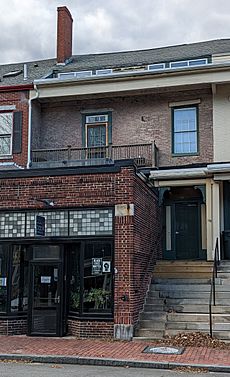Lydia Neal Dennett facts for kids
Lydia Louisa Neal Dennett (born August 17, 1798 – died June 4, 1881) was an amazing woman from Portland, Maine. She was an abolitionist, meaning she worked to end slavery. She was also a suffragist, which means she fought for women to have the right to vote. Her home was a secret safe place on the Underground Railroad, helping people escape slavery. Dennett even helped a brave woman named Ellen Craft escape to England. Later, Lydia became very involved in getting women the right to vote. She was a leader in the American Woman Suffrage Association and started the first big effort in Maine to get women the vote.
Lydia Dennett's Early Life and Fight for Freedom
Lydia Louisa Neal Dennett was born in Eliot, Maine on August 17, 1798. She was the first cousin of a famous writer named John Neal. Lydia was taught by Quakers, a group known for their peaceful beliefs and strong support for equality.
Lydia married Oliver Dennett, and they moved to Portland, Maine. Their home on Spring Street became a very important stop on the Underground Railroad. This was a secret network of safe houses and routes that helped enslaved people escape to freedom. The Dennetts even had a special "closed carriage with a fine pair of horses." This carriage was provided by an anti-slavery group to help people escaping slavery reach safety without being seen.
Lydia Dennett was very brave. In the 1840s, she and another abolitionist, Elizabeth Widgery Thomas, stepped in during a riot. This riot happened at a meeting of the Portland Female Anti-Slavery Society. Dennett and Thomas helped a speaker named Stephen S. Foster get to safety during the chaos. Lydia also played a key role in helping Ellen Craft, who had escaped slavery, and her husband flee all the way to England for their safety.
Leading the Way for Women's Rights
In 1852, Lydia's husband, Oliver Dennett, passed away. But Lydia did not stop her important work. She continued to fight, especially for women's rights. This meant working to make sure women had the same rights and opportunities as men.
In 1869, Dennett joined the executive committee of the American Woman Suffrage Association (AWSA). This group worked hard to get women the right to vote. The next year, she was a vice president for a special event called the Woman's Suffrage Bazar in Boston. By 1872, Lydia Dennett was chosen to be the vice president of the AWSA's executive committee.
In that same year, she led the very first petition campaign for women's suffrage in Maine. A petition campaign is when people collect signatures to ask the government to make a change. She also led Maine's first petition campaign to give indigenous people the right to vote.
Lydia Dennett passed away on June 4, 1881. She was buried in Evergreen Cemetery in Portland. Her work helped pave the way for important changes in American society.


